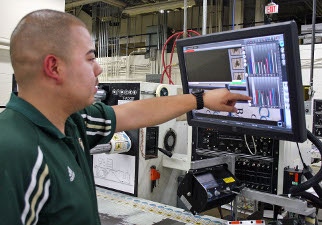
Weber Packaging Solutions Inc., a lea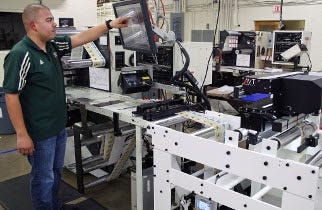
rrr1 - W-system.jpg
ding worldwide manufacturer and supplier of labels and labeling systems since 1932, has purchased six PrintVision/Helios II 100 percent inspection systems from Advanced Vision Technology LTD. (AVT) for installation at its 320,000-sq-ft world headquarters in Arlington Heights, IL.
Weber Packaging Solutions coats its own mill rolls with pressure-sensitive adhesives, slits them to customer specifications and print all orders on the latest flexographic or digital label presses. These high-speed presses produce labels in up to 10 colors, including a 4-color process. With more than 100 different combinations of paper and film face stocks coupled with numerous adhesives, Weber can create a label for essentially any application.
The company also makes a range of RFID smart labels using an innovative method of inserting RFID inlays during the flexographic conversion process. In addition, Weber designs, engineers and fabricates a line of automatic label printer-applicators that are made to customer specifications, with a choice of print heads and application methods. RFID models also are available.
John O'Leary, Weber's vp of manufacturing, says, "We have had AVT's ProoFit Systems for a number of years, and they have worked out very well for us. The ProoFit system does an excellent job and AVT has provided exceptional service."
ProoFit is a system that compares printed material, proofs or files with an approved reference, such as a digital file, proof or print. Based on advanced image processing technology, ProoFit provides precise control of the various elements of the printed products including graphics and characters. During the verification process, the detected deviations are displayed on the screen. The entire inspection job, including the results, is archived, and a customized report is provided. ProoFit assures quality, fast and efficiently, and eliminates errors due to the limitations of the human eye or operator fatigue. It approves revisions and proof printouts and prints the correct revisions and languages. It ensures that the job will be printed correctly before commencing printing.
Vision defect detection
O'Leary continues, "We have been looking to upgrade our vision defect detection systems for a few years. We have pharmaceutical, nutraceutical and medical device manufacturers as customers, and it is becoming almost a requirement to utilize this technology to guarantee the quality of the labels their products demand.
"Another benefit of the vision system is it will essentially eliminate waste and over-production of labels. In our current system, if an operator overlooks a recurring defect, we produce labels that will be scrapped. Depending on how long that continues, we can produce a lot of scrap. In addition, to compensate for defects, we produce more labels than we need to be sure that we have enough good labels to ship to our customer. With the vision system in place, we will produce just the number of labels that we need for each job."
After having discussions with AVT over the years, Weber was intrigued by the features of the AVT PrintVision/Helios II system, which is one of the most advanced 100 percent automatic inspection solutions in existence for label and narrow web printing. O'Leary says, "With the success we've had with AVT, they were an easy place to start when we began looking for 100 percent inspection systems."
Weber took a more detailed looked at the PrintVision/Helios II system at Label Expo 2010. O'Leary says, "We were very impressed by the user interface as well as how easy it was to isolate several different areas on a label with various degrees of scrutiny.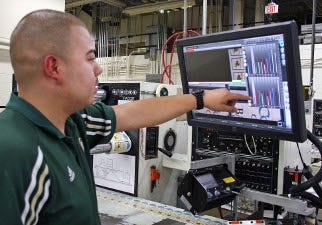
rrr3 - W - oerator.jpg
We determined that we could benefit from not only upgrading our systems on our rewind inspection equipment, but could also add systems to our 10-color flexo presses to help reduce scrap by alerting the operator sooner to correct a defect.
"Since we also print labels on digital presses and convert those labels on a digital finishing machine, we decided it would make sense to add one to the digital finisher to ensure defect free product coming off of that equipment as well."
O'Leary continues, "To help us make the decision, our AVT sales representative took us to another customer site where we were able to see the system setup and operating in live production. We were able to discuss the ease of use with the other customer's operator and manager. From that point we were sold."
AVT's PrintVision/Helios II system delivers process control and 100 percent quality assurance capabilities throughout the entire print production workflow, from setup through printing to finishing. The system uses sophisticated algorithms designed to detect defects, and additional dedicated algorithms have been developed to meet label-specific needs, such as character defect detection, die-cut miss-register and matrix removal problems.
PrintVision/Helios II detects every type of printing or finishing fault on labels as soon as they occur, including color misregister, color variations, hazing, misprints, defects to the text, spots, splashes, die-cut problems, incorrect bar codes, missing labels and other print problems.
PrintVision/Helios II has the ability to inspect any substrate type, including transparent and reflective materials, as well as any label size or shape. The system meets the requirements of all label and narrow-web applications, across a spectrum of different industries, from the demanding pharmaceutical and cosmetic industries to the mass production environment of food and beverage.
On rewinders and presses
Weber purchased six PrintVision/Helios II systems. Two have been installed on rewinders and were operating during Packaging Digest's visit. The other four systems will be installed on presses by the end of the year.
PrintVision/Helios II features a simple, intuitive user interface, designed with full touchscreen compatibility. After a guided short setup, the system is up and running with user-friendly screens and controls that help operators streamline the detection process. For each label, the operator scans an acceptable image into the computer, and it then compares the image of every label passing through the unit with this acceptable image on the operator's screen.
O'Leary says, "T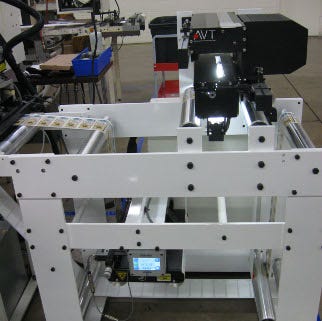
rrrr4 - W - AVT.jpg
he operator can set the tolerance for each type of defect that might occur and tell the computer to accept or reject that defect. This allows the system to be more forgiving of specific items. Otherwise the system will shut the rewinder down for minor defects. This system is much more user friendly than other systems we looked at."In the rewinder operation, a roll of printed film is mounted on the inlet end of the rewinder. The film is pulled through a series of rollers and travels to the Helios II unit where it passes between a light and the camera. The images from the camera are sent to the operator's screen as described previously.
Any defects above the tolerance limits set by the operator cause the rewinder to stop, and the label with the defect is displayed on the screen with the defect identified. The operator then takes action, such as replacing the defective label on the web with a good label or removing a section of the web. Operating parameters and tolerance limits for each label are retained in computer memory and can be recalled by selecting the label on the HMI screen.
As part of the project, Weber installed Fife-500 web-guiding systems from Maxcess to ensure that the film is rewound properly. The film travels through ultrasonic sensors on the unit that detect the edges of the film, and a controller pivots the unit to keep the web of labels perfectly in-line as they travel to the rewinder.
While a Helios II system on a rewinder initiates a response from the operators to correct th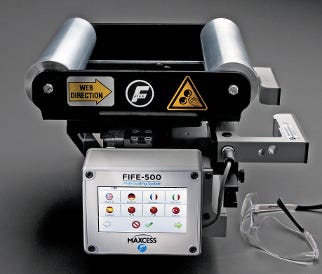
rrrr5 - W - Fife1.jpg
e problem, the system on a press identifies defects in the printed web that will later be corrected by the rewinder operator as described above. In this process, each of the presses will be linked to label applicators that will apply a label to the edge of the roll where the defect is identified to flag it for the rewinder to remove in the next operation.
Add-on modules
The PrintVision/Helios II system has a number of add-on modules, and the systems at Weber Packaging Solutions include most of these. Available modules include:
PrintFlow Manager is a quality data management system that enables the archiving of jobs and parameters and features a complete reporting mechanism for all of its printed roll features. Using its quality statistics features, managers can monitor, analyze and control the quality of the production process from their desktop computers. The PrintFlow Manager is a software module that can be installed on any PC connected via network to AVT systems in the site. Reports can be analyzed, printed, saved, or exported to Excel sheets.
Bar code module verifies and grades linear, matrix codes and variable-data bar codes, compares them to the corresponding human-readable number and verifies them against a database. The system also supports e-pedigree standards and workflow, used in the pharmaceutical market to track and trace pharmaceutical products.
Clear-on-clear Support enables easy and accurate defect detection by means of a special backlight mechanism that illuminates transparent labels on transparent liners or transparent films.
Reflective Support enables the inspection and detection of defects on reflective materials and inks, while maintaining the same high-quality standards for both diffusive and reflective parts.
JobRef enables ve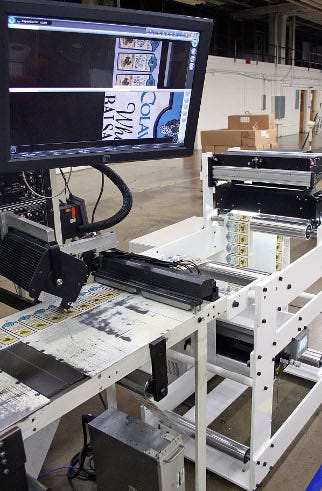
rrrr2 - W- screen .jpg
rification at the setup stage by automatically comparing the current job to the original, customer-approved digital PDF file. The printer can then determine the accuracy of job content, such as text, language and graphics, and whether there are problems in the printing plates, thereby preventing costly initial errors.
MasterRef enables printers to save the master image of each job, which is then used to verify that the repeating jobs are identical to the original, thereby preventing production and shipment errors.
ProMIS provides bi-directional communication with MIS systems in the print production environment, which enables shorter and faster setup, prevents setup mistakes and increases automation. ProMIS also provides more accurate information to MIS systems, for better control over raw materials and production.
WorkFlow Link is the bridge between a press and a rewinder. When Helios II detects a defect on the press, it records the exact location in a SQL database of a defect on the roll running through the press. When the roll is put onto the rewinder, this data can be viewed and used by the WorkFlow Link control station on the rewinder to stop the rewinder in the exact location of the defect for correction. The WorkFlow Link is simple and easy to implement, and supports different configurations according to production flow and customer needs. Weber plans to install this module on a future digital finishing installation.
Commenting on the sale to Weber, Amir Dekel, corporate vp marketing at AVT, says, "For AVT to be recognized by one of the leading label manufacturing companies in the world is important for our company. It is confirmation that our state-of-the-art technology is meeting the highest standards of the industry, and it is working reliably in any production environment. These inspection systems will guarantee that Weber will deliver labels that are 100 percent inspected, 100 percent of the time. This is adding real value to customer care."
So far, things are working out well for Weber with the AVT systems. O'Leary says, "We had high expectations about AVT based on our experience with their ProoFit systems, and they have lived up to those. There were two AVT representatives here during the installation of the Helios II system on the rewinders and a third person came for training. AVT will send another person when we install the systems on our presses to train those operators and refresh training for others."
Advanced Vision Technology Ltd., 770-541-9780. www.avt-inc.com
Maxcess, 800-639-3433. www.maxcessintl.com
Weber Packaging Solutions Inc., 800-843-4242. www.weberpackaging.com
About the Author(s)
You May Also Like


